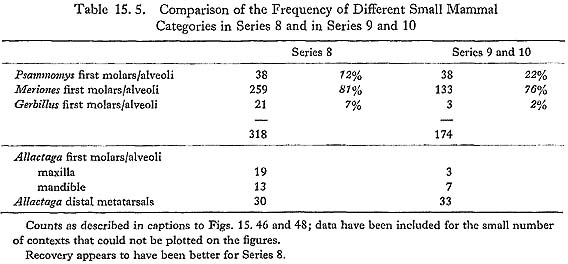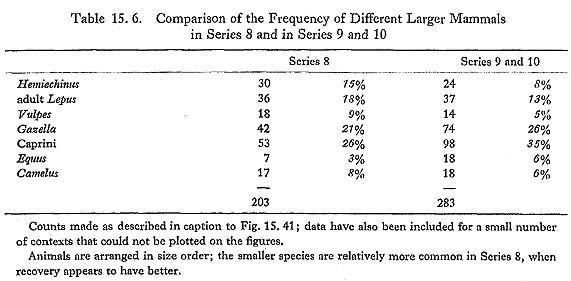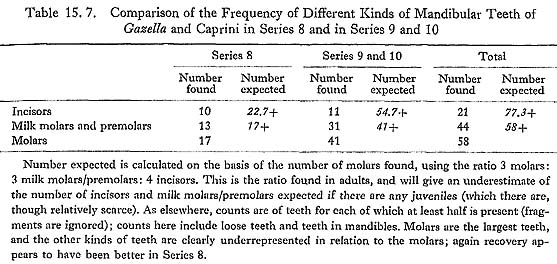CHAPTER 15
The Animal Bones from the 1974 Excavations at Douara Cave
Sebastian Payne
Trinity Collage, University of Cambridge
| ( 7 / 10 ) |
15. 3. 2 Preservation and recoveryAfter bones are brought to a cave, they may be destroyed in a variety of ways, and, in particular, by unfavorable soil conditions (e.g. too acid or too alkaline), and by frequent changes in temperature and humidity. The good preservation of small and delicate bones from much of the deposits, together with the scarcity of bones in eroded condition, show that soil conditions at Douara Cave were generally good for bone preservation, though the scarcity of bones at the front of the cave and in the top 10-20 cm of the deposits suggests that bone may have been destroyed in these areas. The presence of bones lightly concreted with carbonates (Fig. 15. 40, indicated by "c") also suggests some solution and downward percolation of carbonates. Further bias may be cause by the loss of smaller bones during excavation (Payne, 1972). All the excavated earth from the 1974 excavations at Douara Cave was dry-sieved with a 3 mm mesh, but field experiments show that much identifiable bone can be missed even when earth is dry-sieved (Payne, 1975). The possibility that the concentrations of small bones described above may have been created by differences in preservation and/or recovery can safely be rejected, as the different patterns of distribution shown by rodents such as Meriones (Fig. 15. 46) and by bats (Fig. 15.36), both of whose bones are of similar small size, cannot be explained in this way. Different distributions are again shown by ostrich eggshell fragments and thinner eggshell fragments (Fig. 15. 57); again this cannot be explained simply in terms of differences in preservation and recovery, and must reflect real differences in distribution at the time of deposition. At the same time, there is clear evidence that some bone was missed during excavation. Specimens with new breaks and jaws with empty alveoli from which teeth have been lost very recently (the alveoli are clean and brightly-colored, without any soil staining) are fairly common, and often the joining pieces and missing teeth could not be found, even when the bone samples from all the adjoining units were searched through. This is particularly clear in the case of the Hemiechinus mandibles: over 20 edentate mandibles and mandible fragments were found, and often it was clear that teeth had been lost recently, and yet not a single loose tooth was found. Such losses are more important for the smaller animals, and may have a considerable effect on data on the relative frequency of the different rodent genera. Recovery at Douara Cave appears to have been better in the first line of squares to be excavated in 1974 (Series 8) than later in the same season (Series 9 and 10). This is reflected in a number of ways by the data-for instance by the relative frequencies of Gerbillus (small), Meriones (medium) and Psammomys (larger), and by the ratio of Allactaga jaws to metatarsals (Table 15. 5). Allactaga metatarsals are relatively large; even in the Series 8 squares, maxillae and mandibles are scarcer than metatarsals, while in the Series 9 and 10 squares they are very much scarcer, Gerbillus is scarcer, and Psammomys is relatively commoner.
Data for the larger mammals are certainly less seriously affected. Frequencies of smaller species, such as hedgehogs (Hemiechinus), hares (Leptus), and foxes (Vulpes) are relatively higher in Series 8 than in Series 9 and 10, but the change in percentages is relatively slight (Table 15. 6). Losses are also indicated by the underrepresentation of smaller bones and teeth in relation to larger bones and teeth. Gazella and caprine incisors, for instance, should be represented at a ratio of 4: 3 as compared with lower milk molars and premolars, and at the same ratio or more as compared with lower molars, but, being smaller, they are easily missed and are underrepresented in the Douara Cave samples (Table 15. 7).
Having said this, however, we should point out that the standard of recovery at Douara Cave is still unusually good by comparison with most excavated and published sites; and though the figures are slightly biased, and some allowance must be made for this bias, the bias is very much less serious than in most published samples. |


